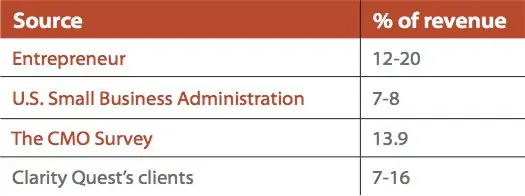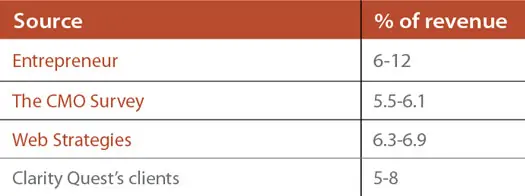Companies, large and small, often struggle with how to allocate time, personnel, and budget to marketing so they will make the most impact on top-line revenue. Never fear; we have answers to frequently asked questions.
How much should I spend on marketing?
We advise clients to spend at least 5% of incremental revenue goals on marketing. Our most successful clients with under $25 million in revenue spend 5% to 8% of OVERALL revenue on marketing.
Marketing spend as percentage of projected revenue:
Startups and small companies <$25 million

Established companies >$25 million

Larger clients spend a bit less as a percentage of revenue, but they get economies of scale on marketing tools, spend, etc.
For more, see our white paper on Five Ways to Set an Optimal Marketing Budget.
How should I spend my marketing budget?
No matter the type of company or industry you’re in, you need the following for successful marketing efforts:
- The best website you can afford. Your website is going to be the foundation on which all your marketing will build on. I see companies that were to sell their products for six-figures with a single splash page website. This does not work. I’ve never regretted a single dime I’ve spent on our website. It’s our company’s best salesperson bringing in many qualified leads every month. Our client Cellero grew by 6X based on a robust e-commerce website with best-in-class search rankings.
- Consistent, quality content. There’s no getting around the content generation, so you’ll need to figure out the magic number of durable and timely content pieces required each month to bring in the lead volume you seek. Small startups can get by with 4-5 blog posts per month; enterprise companies need much more to feed campaigns.
- Send email newsletters to a clean opt-in list. Ann Handley is a master at e-newsletters. She recommends biweekly sends for optimal engagement. That’s a lot of content, so at a minimum, get a monthly newsletter out. Quarterly is far too infrequent for folks to remember your brand.
OK, I’m rocking my website, content, and email. Now what?
Once you’ve laid a robust foundation with a best-in-class website, a way to consistently generate quality content, and you’re emailing your opt-in lists, it’s time to move to the next phase. What you do next depends on the types of products or services you offer.
-
Search Engine Optimization (SEO)
Getting to the top of page 1 search results is an excellent investment for companies that have customers actively searching for the problem they solve (or the solution they offer). If customers aren’t aware that your solution exists yet, they probably aren’t searching for it. However, they may be searching on how to solve their problems, and you can write content that shows them the way out of chaos.
-
Search Engine Marketing (SEM)
Call it PPC, SEM, or search advertising, online ads can play a vital role in shifting customers to your website and content. Search, display, and remarketing ads can convert, but in specific scenarios.
-
Google Ads and Bing Ads
These are excellent fits for companies that have customers actively searching for the problem they want to solve URGENTLY. Examples: Cybersecurity companies in MA, Corporate COVID Testing for Employees. They are not great for complicated products that require nurturing and a long sales cycle.
-
Paid Social
One of the most frequent questions we get asked is, “Should I advertise on social media channels?” As part of an overall marketing strategy, social media is one of the fastest and most cost-effective ways to reach a wide audience and generate buzz about your healthcare, technology, or biotech solution.
-
Organic Social
If you know your buyers, influencers, or job recruits engage on social media, then you need to be there. Don’t know if they are on a channel? Try SparkToro. It’s an amazingly affordable audience intelligence platform created by the founder of MOZ, Rand Fishkin.
If you find a few interesting channels, focus on dominating ONE before trying to dominate the whole social landscape. If you are a B2B company, this will probably be LinkedIn or YouTube, although Facebook can work surprisingly well for some demographics. Also, use a social automation tool like Co-Schedule or Sprout Social. Just as complex email cadences are far easier to manage with marketing automation systems, social sharing campaigns are much more efficient with the right tech stack.
What if I can’t handle all this in-house?
Have you thought about outsourcing all or a portion of your marketing function? Marketing is complex and getting more so every day. It would help if you had experts for each channel and marketing system to maximize the investment.


